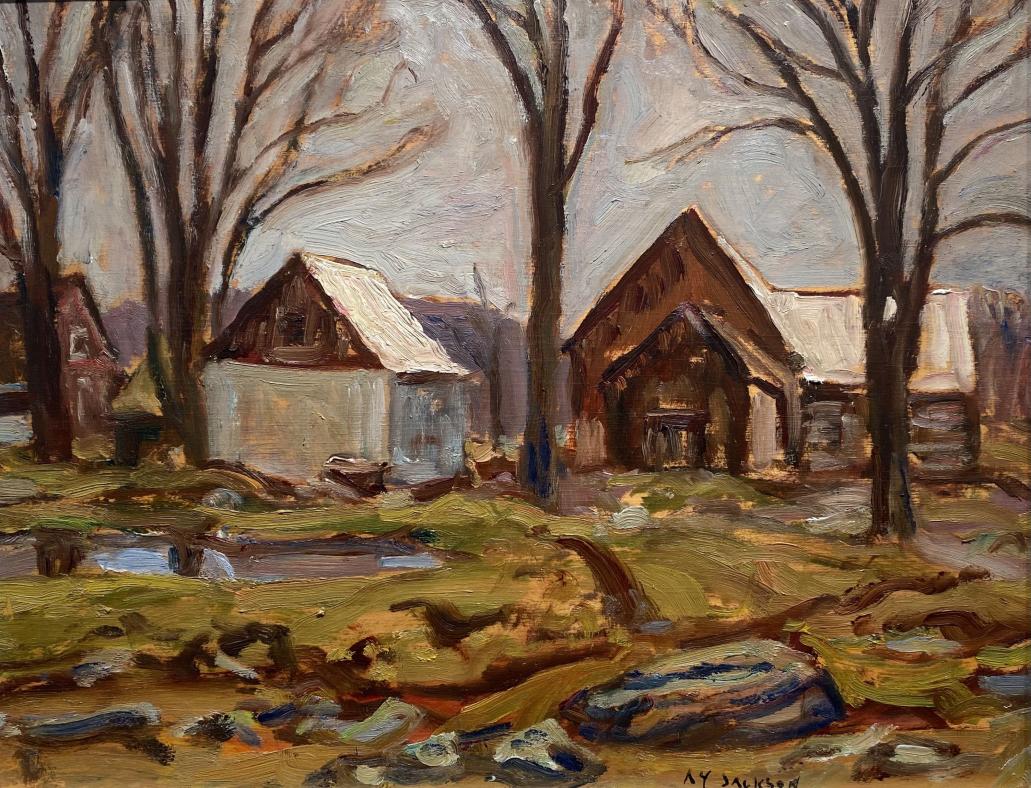Alexander Young (A.Y.) Jackson - West Templeton, Que
- West Templeton, Que
- Oil on Board
- 10.5 x 13.5 in
- 1967
- Price available on request
- Loch Gallery, Calgary
signed front, titled and dated on verso
Alexander Young Jackson CC CMG RCA LL.D. (October 3, 1882 – April 5, 1974) was a celebrated Canadian painter and a founding member of the Group of Seven. Jackson's influence was pivotal in the development of Canadian art, bridging the artistic communities of Montreal and Toronto. His career spanned various roles, including serving as a war artist during World War I (1917–19) and teaching at the Banff School of Fine Arts (1943–1949). In his later years, he was the artist-in-residence at the McMichael Canadian Art Collection in Kleinburg, Ontario.
Born in Montreal, Jackson was the son of Eliza Georgina (Young) and Henry Allen Jackson. After his father abandoned the family, young Jackson worked at a lithograph company, which sparked his interest in art. He took evening classes at the Art Association of Montreal in 1902. In 1905, Jackson traveled to Europe, studying Impressionism in France and attending the Académie Julian in Paris. His work was first recognized when his painting Paysage Embrumé was accepted by the Paris Salon in 1908.
Upon returning to Canada, Jackson settled in Sweetsburg, Quebec, where he painted works like Edge of the Maple Wood. His fortunes changed after J. E. H. MacDonald and Lawren Harris took interest in his work, leading Jackson to move to Toronto and join the Studio Building, a hub for Canadian artists. There, he developed a close friendship with Tom Thomson, which inspired many painting trips to places like Algonquin Park. Jackson served with the Canadian Army during WWI and was later appointed as an official war artist.
Post-war, Jackson returned to the Studio Building and became a central figure in the Canadian art scene. He was instrumental in forming the Beaver Hall Group in Montreal, emphasizing individual expression over formal art schools.
In 1919, Jackson and six colleagues founded the Group of Seven, aiming to depict the rugged Canadian landscape in bold new ways. Their work was initially controversial but eventually recognized as groundbreaking. Jackson also contributed to the Canadian Group of Painters in 1933, continuing his influence on Canadian art. Jackson's later years were marked by extensive travel and painting expeditions across Canada, including the Yukon and the Northwest Territories. He played a key role in the Canadian War Art Program during WWII and was part of the Sampson-Matthews silkscreen print program. Jackson retired from the Studio Building in 1955, moving to Manotick near Ottawa. His autobiography, A Painter's Country, was published in 1958, dedicated to J. E. H. MacDonald. After a stroke in 1965 ended his painting career, Jackson moved to the McMichael Conservation Estate in Kleinburg, where he passed away in 1974. He is buried on the grounds of the McMichael Canadian Art Collection. A.Y. Jackson's legacy endures through his contributions to Canadian art, his role in the Group of Seven, and his dedication to capturing the essence of the Canadian landscape. His works remain a testament to his vision and influence, celebrated in galleries and collections across Canada.
More Artwork from this Artist
West Templeton, Que
- Oil on Board
- 10.5 x 13.5 in
- 1967
- Price available on request
Creek at Montpellier, Quebec
- Oil on Board
- 10.5 x 13.5 in
- 1962
- Price available on request
Winter Afternoon
- Oil on Panel
- 8.5 x 10.5 in
- circa 1928
- Price available on request



